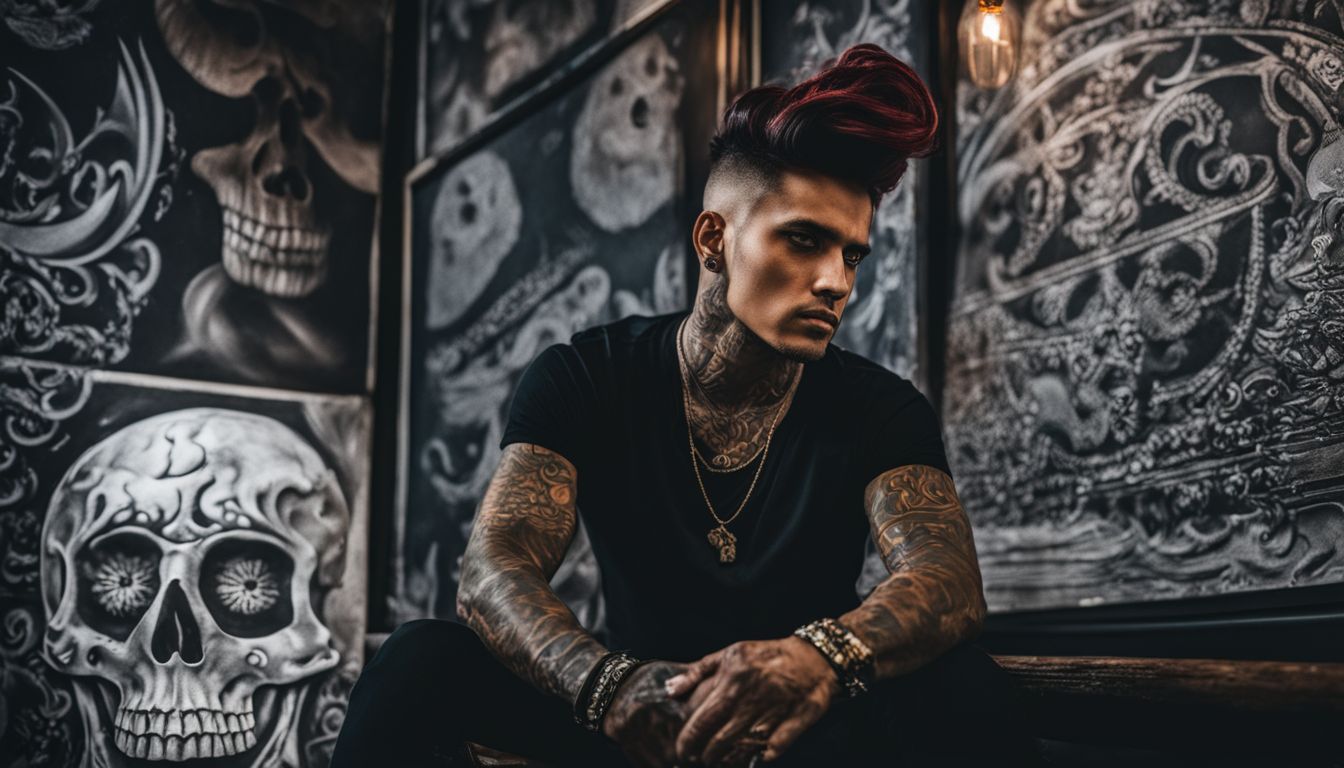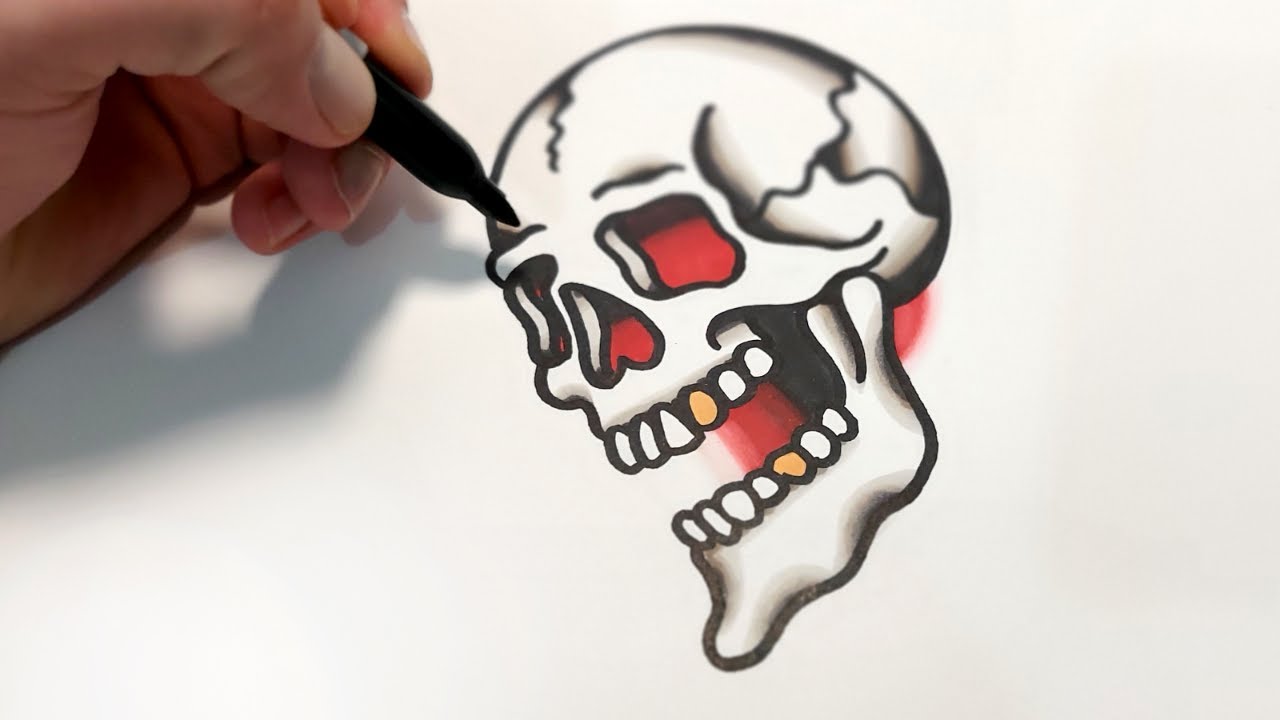Exploring the Symbolism of Traditional Skull Tattoos
Create your own unique tattoos and art for your home
Choosing a tattoo can be tough, especially when it’s about something as powerful as a skull. Skull tattoos are not just cool designs; they carry deep meanings that go back centuries.
This blog post will take you on a journey through the history and symbolism of traditional skull tattoos, helping you understand why they might be the perfect choice for your next ink.
Keep reading to uncover the mysteries behind these iconic symbols!
Key Takeaways
- Skull tattoos are rich in cultural history, originally representing mortality and remembrance but now also symbolizing luck, protection, intellect, and the afterlife.
- These tattoos have roots in ancient civilizations and have evolved through military affiliations into a popular form of body art with diverse designs like sugar skulls and Sailor Jerry styles.
- The symbolism of skull tattoos extends beyond death to encompass themes like rebellion against societal norms, transformation following personal growth or change, and honoring loved ones who have passed away.
- Traditional skull tattoo designs incorporate elements such as roses for life’s fragility, snakes for rebirth, clocks for time’s passage, and various other symbols enhancing their meanings.
- Personal expression is a key aspect of traditional skull tattoos; individuals often use them to reflect on personal beliefs about mortality or to connect with cultural heritage.
The History of Traditional Skull Tattoos
Originating from ancient civilizations, traditional skull tattoos have held cultural significance as symbols of mortality and remembrance. Over time, these designs have evolved into iconic imagery within the tattooing world, with distinct stylistic elements that continue to inspire contemporary artists.
Origin and Cultural Significance
Skull tattoos carry a powerful message across cultures, often associated with death and mortality. People wear these designs to show that they aren’t afraid of the end or to honor those who have passed away.
In many traditional societies, skulls are not just symbols of doom; they can also represent luck, protection, intellect, and the afterlife. Skull imagery serves as a stark reminder of our own transient nature on this earth.
Cultural interpretations of skull symbolism vary widely from one region to another. Take Japanese traditions for example – skulls there are seen as guardians and symbols of strength; fierce warriors defending their kin even beyond death.
Whether paired with roses showcasing life’s delicacy or entwined with snakes hinting at danger and change, each skull tattoo weaves its own narrative into the rich tapestry of traditional tattoo culture.
From scary tokens to sacred icons – these ancient motifs continue to evolve while maintaining their profound ties to humanity’s shared understanding of life’s fleeting beauty and inevitable conclusion.
Evolution of Traditional Skull Tattoo Designs
Traditional skull tattoo designs have evolved over time, reflecting changes in cultural and artistic trends. These tattoos initially emerged as part of indigenous rituals and military affiliations but have since transitioned into a popular form of body art.
The evolution of traditional skull tattoo designs has seen a fusion of styles, from the classic black-and-gray ink to vibrant neo-traditional interpretations. This progression has allowed for greater creativity and personalization in the symbolism associated with these tattoos.
The imagery within traditional skull tattoo designs has experienced a shift towards incorporating diverse elements such as flowers, snakes, or geometric patterns. Artists now blend traditional iconography with contemporary influences to create unique and meaningful representations for their clients.
Symbolism in Traditional Skull Tattoos
Traditional skull tattoos hold deep symbolism, representing concepts such as death and mortality, remembrance and honor, rebellion and nonconformity, and transformation and change.
The intricate designs of these tattoos often showcase the complexity of these meanings.
Death and Mortality
Skull tattoos often signify an acceptance of mortality and a reminder of the impermanence of life. This symbol can represent bravery, fearlessness, or even defiance in the face of death.
The inclusion of other elements like snakes, roses, or hearts further expands the meaning of these tattoos, emphasizing themes such as transformation, fragility, love, and devotion.
The skull is a powerful image that encapsulates human contemplation on our own transience. Incorporating it into a tattoo serves as a perpetual memento mori—a visual reminder to seize the day and live life to its fullest potential.
Remembrance and Honor
Skull tattoos are often used as a way to honor and remember loved ones who have passed away. The image of a skull can represent the cycle of life and death, serving as a reminder that those we have lost will always be with us in spirit.
Many individuals choose to ink their skin with traditional skull tattoos as a tribute to the memory of someone special or to commemorate an important event. These designs allow for personal expression while honoring the legacy of those who have left an indelible mark on their lives.
Additionally, these tattoos can signify respect for cultural traditions by embracing certain symbols or practices associated with remembrance and honor. With the inclusion of elements like flowers, candles, or religious imagery, traditional skull tattoos can convey deep emotions and pay homage in meaningful ways.
Rebellion and Nonconformity
Rebellion and nonconformity are often associated with traditional skull tattoos, reflecting a daring and independent spirit. Many individuals choose to get skull tattoos as a symbol of defiance against societal norms and expectations.
The imagery of the skull itself has long been linked to rebellion, as it represents a fearless attitude toward mortality and embraces the idea of living life on one’s own terms. Additionally, incorporating other elements such as flowers or flames into the design can further emphasize this sense of resistance, adding depth to the meaning of the tattoo.
Skull tattoos also convey a message of nonconformity, rejecting conventional ideas about beauty and art. By choosing to adorn their bodies with these bold symbols, individuals express their rejection of mainstream ideals while embracing an alternative form of self-expression that defies expectations.
Transformation and Change
From rebellion and nonconformity to transformation and change, traditional skull tattoos hold deep symbolic meanings. The incorporation of skulls in tattoos can represent an individual’s desire for personal growth or a significant shift in their life.
Skull and snake tattoos, for instance, symbolize the transformative nature of change, with the snake representing renewal and rebirth alongside mortality. Additionally, combined with other elements such as flowers or flames, skull tattoos can convey the idea of embracing change as part of life’s journey.
This signifies that individuals who choose this tattoo want to express their readiness for transformation and their ability to adapt to new beginnings.
Traditional Skull Tattoo Iconography
Traditional skull tattoos come in different styles and have various common elements and additions that contribute to their overall symbolism and visual appeal. To learn more about the traditional iconography of skull tattoos, keep reading!
Traditional Skull in Different Styles
Skulls in Traditional Tattoo Styles
- Skull and Crossbones: Represents danger, often associated with pirates and can symbolize a rebellious nature.
- Sugar Skulls: Originated from Mexican culture, used to celebrate the Day of the Dead and represent the cycle of life and death.
- Tribal Skulls: Depict skulls with intricate patterns inspired by various indigenous cultures, symbolizing heritage and identity.
- Realistic Skulls: Detailed depictions that emphasize the human anatomy, often symbolizing mortality and the fragility of life.
- Sailor Jerry Skulls: Inspired by traditional American tattoo artist Sailor Jerry, these skulls are bold and iconic, embodying a classic vintage aesthetic.
Common Elements and Additions
Skull tattoos often incorporate various elements and additions to enhance their meaning and visual impact. These additions can include:
- Roses: Adding a rose to a skull tattoo symbolizes the juxtaposition of life and death, representing the fragility and beauty of life.
- Snakes: Including a snake in a skull tattoo can symbolize danger, transformation, and mortality, as snakes are often associated with change and rebirth.
- Hearts: A skull with a heart conveys the idea of eternal love and devotion, creating a poignant contrast between life and death.
- Flames: Incorporating flames into a skull tattoo can represent passion, intensity, or transformation, adding depth to the symbolism of the design.
- Flowers: Skull tattoos combined with flowers can signify the cycle of life, growth from decay, or remembrance of loved ones who have passed.
- Clocks: The addition of a clock to a skull tattoo emphasizes the fleeting nature of time and mortality, serving as a reminder to live fully.
- Wings: Adding wings to a skull design can symbolize freedom, spirituality, or ascent beyond mortality.
- Crossbones: Traditional imagery often includes crossbones alongside skulls as a universal symbol of danger or warning.
- Crowns: Incorporating a crown into a skull tattoo can convey themes of power, royalty, or overcoming obstacles.
- Birds: Including birds in skull tattoos may symbolize freedom, transition between life and death or serve as messengers between worlds.
The Appeal of Traditional Skull Tattoos
Traditional skull tattoos have an appeal due to their classic and timeless design, versatility in placement, and personal and cultural connections. Read on to discover more about the symbolism of traditional skull tattoos!
Classic and Timeless Design
Skull tattoos have stood the test of time, showcasing a classic and enduring design that has remained popular across cultures for centuries. The bold and striking image of a skull holds a timeless appeal, making it a staple in traditional tattoo art.
Its versatile nature allows for various interpretations, ensuring its continued relevance in the world of tattooing.
The enduring popularity of traditional skull tattoos lies in their classic aesthetic and deep symbolism rooted in cultural history. The simple yet powerful imagery resonates with many individuals seeking to express themes of mortality, rebellion, or remembrance through their body art.
Versatility in Placement
Skull tattoos offer versatility in placement, making them suitable for various body parts. They can be inked on the arm, leg, back, chest, or even behind the ear. This flexibility allows individuals to showcase their traditional skull tattoo based on personal preference and symbolism in a unique and individualistic way.
Moreover, depending on size and design intricacy, these tattoos can be worn as standalone pieces or incorporated into larger tattoo compositions.
The adaptability of traditional skull tattoos when it comes to placement creates an opportunity for personal expression and creativity while also embracing the rich cultural significance of this timeless art form.
Personal and Cultural Connections
While the versatility of traditional skull tattoos allows for personal expression, their cultural significance also plays a crucial role in the tattooing tradition. Many people choose to ink these designs as a nod to their heritage or as an act of rebellion against societal norms.
Traditional skull tattoos often hold deep personal meaning, reflecting an individual’s thoughts on mortality, transformation, and remembrance. Additionally, some individuals opt for these tattoos to pay homage to their ancestors or showcase their affiliation with specific subcultures such as bikers or pirates.
Beyond personal connections, traditional skull tattoos also carry rich cultural symbolism across various societies. In Mexican culture, sugar skulls are created during Dia de los Muertos (Day of the Dead) celebrations to honor deceased loved ones—a tradition that has influenced many contemporary tattoo designs globally.
Conclusion
In conclusion, traditional skull tattoos hold deep symbolic meanings for those who choose to wear them. These tattoos represent themes of death, remembrance, rebellion, and transformation, reflecting personal beliefs and values.
The intricate designs and versatile placement options make traditional skull tattoos appealing to a wide range of individuals seeking timeless and meaningful body art. From the rich history and cultural significance to the individualized symbolism represented in each design, traditional skull tattoos continue to captivate and inspire both tattoo enthusiasts and artists alike.
FAQs
1. What do traditional skull tattoos represent?
Old school skull tattoos often symbolize the acceptance of death and the celebration of life, forming a key part of American traditional tattoo art.
2. Can you tell me about the history behind traditional skull tattoo imagery?
The imagery in traditional skull tattoos goes back to vintage tattoo flash from old school artists who infused them with meanings like protection and remembrance, adding depth to these designs over years.
3. How are neo-traditional skull tattoos different from vintage designs?
Neo-traditional skull tattoos blend modern elements with classic symbolism found in old school tattoos to create fresh, yet timeless pieces that honor tattoo traditions.
4. Why might someone choose a skull design for their tattoo?
People may choose a skull design to express various meanings such as change, power, or an acknowledgment of mortality – each rooted in the rich symbolism of traditional tattoo culture.
5. Are there specific symbols often paired with skull art in traditional tattoos?
Yes! In traditional tattoos, skulls are frequently combined with other symbols like roses or snakes which enhance their significance within the cultural context and tradition of symbolic ink.








